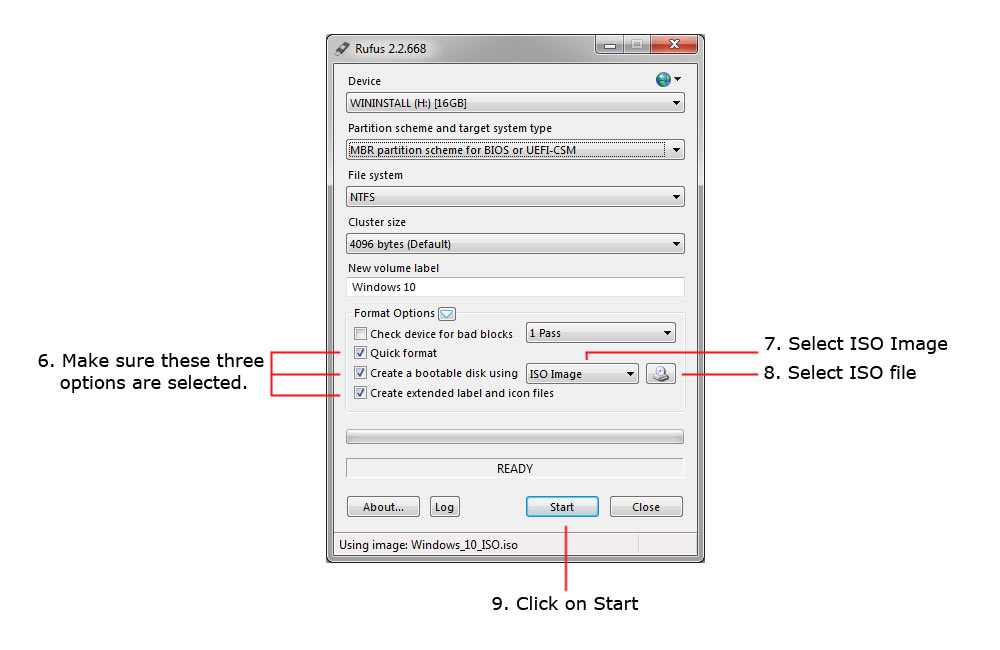
- #Format for bootable fhash drive how to
- #Format for bootable fhash drive install
- #Format for bootable fhash drive archive
- #Format for bootable fhash drive iso
Starting in this case you need from the 1st item - formatting. If an error occurred during the data recording process or the download was interrupted, then you must repeat all the steps again according to the instructions.

It all depends on the characteristics of your computer and the size of Windows itself. After a while, in case of a successful operation, a window with the inscription "Job Done" appears.Ĭreating a bootable USB flash drive with thisinstructions will take you about 10 to 30 minutes. Specify the directory where the previously unpacked Windows is located. Click on the button on the right (with three dot symbols). After that, the selection window becomes active.

In the "Add to Usb disk" menu, check the box "Windows 2000 / XP. Now we need to open the main program WinSetupFromUSB, where we select our device, which will be recorded. At this stage, our USB flash drive is already ready for recording. Then click the "Install / Config" button. Since we are recording the Windows XP operating system, we need to select "Windows NT 5. We return to the initial menu of the Bootice program. Next, you need to change the file format system to NTFS. In the new window, find the entry "USB-HDD mode. Open this utility, select the flash drive to which you want to record, click on "Perform Format". It is called Bootice (it is installed together with the main part). This program for creating a bootable USB flash drive has its own utility for this operation. It is recommended for this work to take a flash drive with a volume of more than 4 GB.ġ. Perform all steps of the instruction step by step. You can always unzip it using any archiver. It does not matter in what format your Windows is stored. Before starting the recording process, you need to unzip the "Windows" into a separate folder. I will describe the creation of a bootable USB flash drive Windows XP. Once you have downloaded the program, you need someprocess the downloaded content.

#Format for bootable fhash drive archive
In the archive with the program there should be several utilities - they are all necessary for successful work. It is freely available, so you can download it for free. All actions will occur in the program WinSetupFromUSB.

Click the “Device” box in Rufus and ensure your connected drive is selected.Hello! Today we will consider creating a bootable USB flash drive. The contents of this drive will be erased, so back up any important files on the drive first.
#Format for bootable fhash drive install
The tool will open immediately-you don’t even have to install it.Ĭonnect a USB drive with at least 2GB of free space to your Windows PC (this may vary depending on your distribution of choice). There are many tools that can do this job for you, but we recommend a free program called Rufus-it’s faster and more reliable than many of the other tools you’ll see recommended, including UNetbootin.ĭownload Rufus and run it on your Windows PC.
#Format for bootable fhash drive how to
How to Create a Bootable USB Drive on Windows For installing Linux to your PC, this is fine-but if you want a live USB that keeps your changes so you can use it regularly on different computers, you’ll want to check out these instructions instead. When you run it, none of your chances (like installed programs or created files) will be saved for the next time you run it. NOTE: This process creates a traditional live USB drive. RELATED: How to Create a Live Ubuntu USB Drive With Persistent Storage
#Format for bootable fhash drive iso
If you’re not sure which one to download, we recommend the LTS release.īelow, we’ll show you how to turn this ISO into a bootable flash drive on both Windows or an existing Linux system. Head to Ubuntu’s download page and download the version of Ubuntu you want-either the stable “Long Term Service” release or the current release. You’ll need to download an ISO file to do this-we’re going to use Ubuntu in our example, but this should work for quite a few different Linux distributions.


 0 kommentar(er)
0 kommentar(er)
